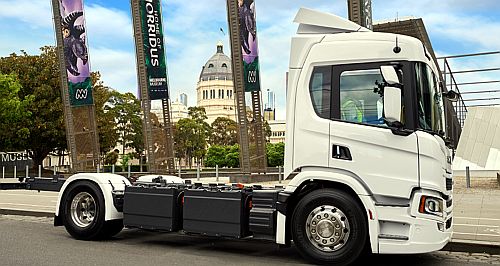BEV trucking doesn’t weigh up, yet: Scania

SCANIA Australia recently imported three battery electric trucks for evaluation, the Swedish-made series production vehicles based on the traditional P-series cab and chassis, but with a mid-mounted permanent magnet electric motor powered by nine lithium-ion batteries with a total output of 300kWh.
The Scania 25 P line-up is available in 4x2 and 6x2 configurations, each featuring a two-speed transmission, total system power of 295kW and 2200Nm (with a 60kW PTO option), and up to 250km range, making it ideally suited to intracity and municipal applications.
Charging is via a CCS Type 2 plug at up to 130kW/200A DC. Scania says the 25 P may be charged in “less than 100 minutes”.
But the importer says acceptance of battery electric trucks locally is far from where it could be, sighting subsidy and infrastructure hurdles as the main barriers to the industry-wide adoption of the technology.
“The interest levels and enthusiasm for the product is good, and we’ve had a lot of enquiries on the 25 P. But the main reason we brought the trucks here at this stage is to ensure the back end, the testing and training, is in place before we go to market,” Scania Australia director of truck sales, Benjamin Nye, told GoAuto.
“The main interest we’re seeing from the industry is from larger fleets, and that is primarily because at this point the accounting just doesn’t work for smaller businesses. That is not the truck’s fault – whether it be us, Volvo or Mercedes-Benz – it is an issue of legislation and infrastructure, that is what is making it (the uptake of BEV trucks) painful.”
Mr Nye said that with improved infrastructure and governmental support, the likes of that seen in Europe, battery electric trucks could dramatically benefit metropolitan road freight networks and significantly reduce noise and air pollution.
“The (BEV) vehicle is two to three times the cost of an internal combustion truck, but you can make those costs fade into the background provided everything else is in place,” he continued.
“But when you deal with the fact that you’ve got three to four tonnes less payload (of a diesel-powered truck), charging infrastructure that is subpar, and an electricity grid that is subpar, it makes it a really hard sell.
“Legislation must change. In Australia, heavy vehicle manufacturers do not get any assistance or dispensation from the government. If we are serious about transitioning towards an electric heavy vehicle fleet, that has to change.”
In addition to the three electric heavy rigid trucks, Scania has already imported a batch of electric bus chassis into the country, the first of which is being bodied by Adelaide’s Bustech for trial use by the South Australian Department of Infrastructure and Transport within its route bus fleet.
“We have brought these first battery electric trucks to Australia to evaluate their performance in local real-work environments, to see not only how they cope with our conditions, but also to experience and demonstrate the benefits of silent running and of course, zero tailpipe emissions,” said Mr Nye.
“If operators can use green energy to charge the batteries of these trucks, their carbon footprint would be extremely minimal compared with a traditional diesel truck.
“In recent times we have seen a significant uptick of interest in the concept of battery electric trucks, not only for last mile deliveries, but also for a wider range of duties. The purpose of this first batch of trucks is to determine where their abilities would be best employed.
“We are very clear-eyed about the existing operating environment in Australia, our national energy generation strategy, as well as the total operating economy of a battery electric truck. While these issues are all in flux, the transition to a more sustainable transport system is underway.”
Pointing to Scania’s home market, Mr Nye said it is possible for the manufacturer to provide a total package of operating solutions for customers keen to add a battery electric vehicle to their fleet.
Using the electric solutions concept, Scania can ensure the vehicle can be charged, operated, maintained, serviced, repaired, financed, and insured, along with long-term and continuous advice and guidance from Scania’s electrification experts.
“This solution is an all-in-one package, tailored to individual operations, with premium electric vehicles at its core,” he added.
Visit GoAuto again soon for our local drive impressions of the 2023 Scania 25 P.